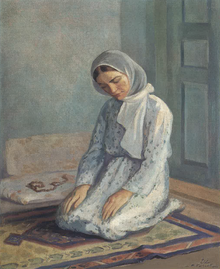|
Sitting in salah Sitting or kneeling (Arabic: جِلسة and قعدة, also جلوس and قعود) is an integral part of salah, or Islamic prayer, along with bowing (ruku' and sujud). Manners of sitting or kneelingThree styles of sitting/kneeling have been reported in the hadiths (accounts of the prophet Muhammad's traditions):
It is sunnah to bend the toes towards Qibla. Overview There can be two occasions of sitting in a regular raka'ah. One is after the first prostration and the other is after the second prostration, sometimes referred to as the tashahhud. The first two styles of kneeling are used alternatively by Muslims after the first prostration and during the first tashahhud. The third style of sitting is used during the final tashahhud while the index finger is pointed towards the qibla, which is the direction of Mecca.[1][2] In the last raka’ah, the prayer is concluded in sitting position by saying the taslim or peace greeting first towards the right and then towards the left.[1][2] SayingsThe Tashahhud, a prayer containing the Islamic testimony of absolute monotheism and Muhammad's divine apostlehood/messengerhood, is recited. Among Sunnis, the prayer is also known as "at-Tahiyyat" by the incipit and includes affirmation of God as the sole object of all worship and supplications for the Prophet and all "righteous servants of God". In the Shia version, according to Ayatullah Sistani,[3] is "Ash hadu an la ilaha illal lahu wahdahu la sharika lah, wa ash hadu anna Muhammadan 'Abduhu wa Rasuluh, Alla humma salli 'ala Muhammadin wa aleh Muhammad". And it will be sufficient if one recited the tashahhud this way: Ash hadu an la ilaha illal lahu was ash hadu anna Muhammadan Sallal lahu Alayhi Wa Aalihi Abduhu Wa rasuluh. SalawatThe tashahhud is accompanied with a recommended salawat in the final sitting:
The wording may vary depending on the various authentic narrations and preferences in each Fiqh school of thought. The greetings in the Shia version, according to Ayatullah Sistani,[4] is "Assalamu 'alayka ayyuhan Nabiyyu wa rahmatullahi wa barakatuh. Assalamu Alaykum." Alternatively, "Assalamu Alayna Wa Ala Ibadi llahis Salihin. Assalamu Alaykum." See alsoReferences
|
